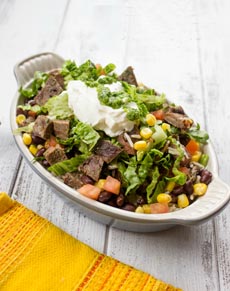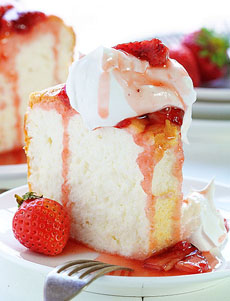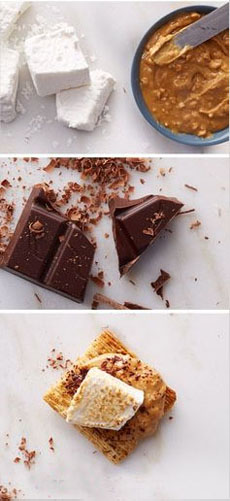|
What’s hot in fast-casual restaurant dining? Layered salad bowls!
The bowls have a bed of salad greens, with layers of toppings such as beans, cheese, corn, dips (guacamole, hummus, salsa), grains, legumes, noodles, proteins, sour cream, tomatoes and more. Each layer of ingredients adds more flavor and texture.
According Katie Ayoub’s article in Flavor & The Menu, Chipotle’s Burrito Bowl now surpasses its burritos in sales. Jamba Juice added five Energy Bowls to its lineup last September. Panera rolled out Broth Bowls in January and KFC launched two new Chicken & Rice Bowls. On The Border introduced Border Bowls in April. The list goes on.
Bowls cross comfort-food and global flavors with better-for-you fresh vegetables and smaller portions of protein. They provide tastes of multiple favorites in one dish. They’re a hit.
Make your own bowls at home with the layer-by-layer guide to ingredients below, and add your own to the list.
A tip: If you plan your menus for a few days, you can have leftover beans, grains and proteins with which to construct your bowls.
|
|

A homemade version of Chipotle’s Steak Burrito Bowl (hey, where’s the grated cheese?). Here’s the recipe, from GimmeDelicious.com. |
BASE
Salad greens plus:
Grains: Quinoa, farro, oats, rice (basmati, brown, cilantro, coconut, etc.)
Pasta: cappellini, penne rigate, ramen, rice noodles, soba noodles, whole wheat noodles
Potatoes: mashed/smashed white or sweet potato, diced boiled potatoes vinaigrette
Pulses: beans, lentils, edamame
PROTEIN
Beef: braised beef or short rib, cubed or sliced steak
Chicken: grilled and cubed or sliced
Egg: fried, hard or soft-boiled, pickled
Lamb: cubed or sliced
Meatballs: beef, chicken, lamb, pork, turkey
Shrimp: habanero-mango glazed
Salmon: mini salmon cakes
Fish: grilled, pepper-crusted
Pork: pulled/shredded
Vegetarian: baked/grilled tofu or seitan, falafel, vegetarian “meatballs”
|
|

From On The Border, the popular Shrimp Border Bowl, with grilled shrimp and
Tex-Mex fixings.
|
|
PRODUCE
Charred: beans, broccoli, carrots, greens, onions
Fresh: arugula, avocado, baby kale, basil, cilantro, corn, jicama, mint, mixed greens, peas/snow peas, radish, tomato, watercress, zucchini
Fruit: apple or pear slices, berries, cranberry sauce, grapefruit or orange segments, stone fruit slices
Grilled: corn, eggplant, green beans, mushrooms, peaches, red onion, zucchini
Roasted: bell pepper, jalapeño, mushrooms, onions, shallots, squash, tomato
FLAVOR BINDERS
Broth: beef, chicken, miso, roasted vegetable, seafood (add ingredients that work in a soup bowl)
Other: Greek yogurt, hummus, sour cream, tzatziki, vinaigrette
Salsa: chimichurri, pico de gallo, roasted tomatillo
Sauce: chipotle sauce, guacamole, pesto, red curry paste, roasted harissa, peanut sauce, tikka sauce (to drizzle)
|
TOPPINGS
Cheese: grated cheddar or mozzarella, crumbled fresh or aged cheeses
Dried fruit: apricot, cherry, cranberry, dates, fig
Fermented produce: cabbage, cucumber, kimchi, turnip greens
Nuts and seeds: candied, fire-roasted, glazed, spiced, toasted
Pickled produce: beets, carrots, onions, peppers, radish, slaw, watermelon
We can’t wait until lunchtime!
|
|












